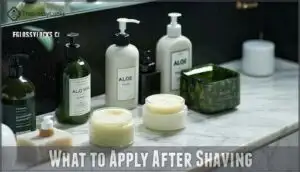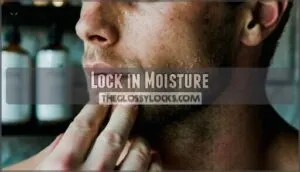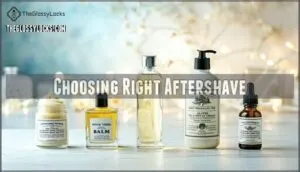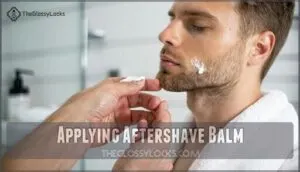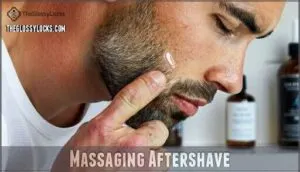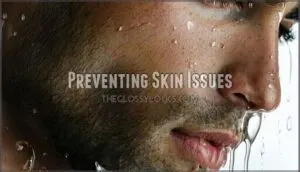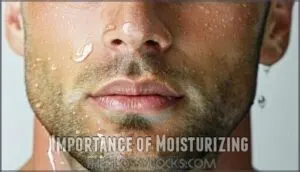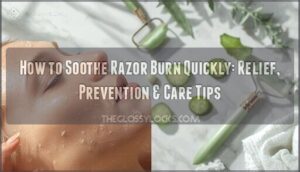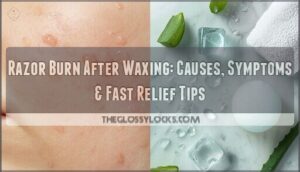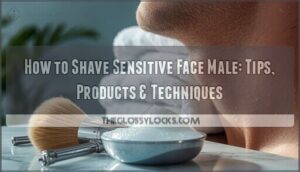This site is supported by our readers. We may earn a commission, at no cost to you, if you purchase through links.
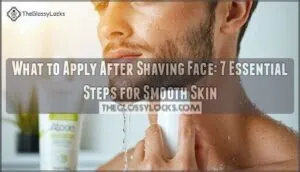 After shaving, your skin needs some TLC to prevent irritation and razor burn.
After shaving, your skin needs some TLC to prevent irritation and razor burn.
Start by rinsing with cold water to close your pores and reduce inflammation.
Pat your face dry gently—don’t rub like you’re scrubbing a stubborn stain.
Apply an alcohol-free aftershave balm or moisturizer while your skin’s still slightly damp.
This locks in hydration and soothes any nicks or cuts.
Look for ingredients like aloe vera or chamomile that calm irritated skin.
If you’re heading outdoors, don’t forget sunscreen since freshly shaved skin is more sensitive to UV rays.
Your face will thank you for this simple routine that transforms post-shave discomfort into smooth confidence.
Table Of Contents
- Key Takeaways
- Shaving Face Care
- What to Apply After Shaving
- Skincare Routine Steps
- Aftershave Application Guide
- Preventing Skin Issues
- Importance of Moisturizing
- Post-Shave Sun Protection
- Frequently Asked Questions (FAQs)
- What should I use on my face after I shave?
- What to apply after removing facial hair?
- What not to apply after shaving your face?
- Is it good to put moisturizer on face after shaving?
- Can I use aftershave on sensitive skin?
- How long should I wait between shaves?
- What ingredients should I avoid after shaving?
- Can women use mens aftershave products?
- Should I shave before or after showering?
- Conclusion
Key Takeaways
- Start with cold water immediately after shaving – it closes your pores, reduces inflammation, and creates a protective barrier against dirt and bacteria that could cause irritation.
- Choose alcohol-free aftershave balms over traditional aftershaves – they provide soothing relief without the stinging sensation while delivering essential moisture that your freshly shaved skin desperately needs.
- Apply moisturizer while your skin’s still slightly damp – this locks in hydration more effectively and helps restore the protective barrier that shaving strips away from your face.
- Don’t forget broad-spectrum SPF 30 sunscreen before going outdoors – freshly shaved skin is twice as vulnerable to UV damage, making sun protection crucial for preventing burns and long-term skin damage.
Shaving Face Care
Proper shaving face care starts with good preparation and ends with the right post-shave routine to keep your skin healthy.
You’ll need to cleanse, prep your skin before shaving, then apply the correct products afterward to prevent irritation and maintain smooth results.
Pre-Shave Preparation
The foundation of smooth shaving starts with proper preparation. Your skin needs attention before that first razor stroke.
Here’s how to prep your face for the best shave:
- Skin Cleansing – Wash with mild cleanser to remove dirt and oils
- Exfoliation Benefits – Gently scrub away dead skin cells and debris
- Warm Washcloth – Apply for 3 minutes to soften hair follicles
- Hydration Importance – Guarantee skin stays moist throughout prep
- Shaving Gel application – Use quality preshave lotion for protection
Consider using a quality preshave cleanser for superior results.
Shaving Techniques
Once your skin’s prepped, proper shaving technique makes all the difference.
Hold your skin taut and maintain a 45-degree razor angle for maximum blade sharpness.
Always shave with hair direction, never against it.
Use short, gentle strokes without pressing hard, and rinse your razor after each pass.
Sharp blades prevent tugging, while correct skin tension guarantees smooth facial shaving every time.
Post-Shave Routine
After you finish shaving, your skin barrier needs immediate attention to prevent shaving irritation relief issues.
Your night routine should focus on soothing and protecting freshly shaved skin through careful routine customization.
Here’s your essential post-shave checklist:
- Rinse with cold water – Close pores and reduce razor burn treatment needs
- Apply sensitive skin aftershave – Choose alcohol-free aftershave balm over harsh postshave lotion
- Check product ingredients – Avoid fragrances that irritate sensitive skin
- Moisturize immediately – Lock in hydration while skin is still damp.
Proper balms offer deep hydration benefits for soft skin.
What to Apply After Shaving
Your post-shave product choice makes all the difference between comfort and irritation.
Aftershave balms work better than alcohol-based options for sensitive skin, providing soothing aftershave relief without stinging. Natural aftershaves containing aloe vera or witch hazel offer gentle razor burn treatment.
Check product ingredients carefully – avoid harsh fragrances that trigger shaving irritation relief needs. Postshave lotion should match your skin type and application frequency depends on how often you shave.
Quality matters more than quantity when selecting your go-to product. For additional soothing, consider aloe vera gel.
Skincare Routine Steps
Your post-shave routine directly affects how your skin looks and feels for days after shaving.
Following these four essential steps helps restore moisture, prevent irritation, and protect your newly exposed skin from damage.
This process is crucial for maintaining healthy and comfortable skin after shaving.
Rinse With Cold Water
After you finish shaving, cold water becomes your skin’s best friend.
This simple step delivers multiple benefits that set the stage for your complete aftershave routine.
Here’s what cold water does for your freshly shaved skin:
- Pore Closure – Cool water tightens your pores, creating a protective barrier against dirt and bacteria
- Redness Reduction – The cooling effect calms inflammation and reduces that post-shave flush
- Circulation Boost – Cold water stimulates blood flow, promoting faster healing and healthier skin
Use Gentle Face Cleanser
After rinsing with cold water, cleanse your facial skin with a gentle face cleanser to remove residual shaving cream and loose hairs.
Choose mild, pH-balanced cleanser types without harsh ingredients that could irritate freshly shaved skin.
Apply using gentle circular motions, focusing on proper application technique.
Many users find a suitable face wash improves their skin.
This cleansing frequency should follow every shaving session to maintain healthy skincare habits before applying aftershave products.
Apply Hydrating Toner
After cleansing away shaving residue, your skin craves balance.
Hydrating toner restores your skin’s natural pH while delivering moisture that aftershave alone can’t provide. Think of it as your skin’s reset button after shaving.
Here’s why toner works wonders:
- Balances skin pH disrupted by shaving and cleansing
- Delivers deep hydration through lightweight application methods
- Preps skin for better moisturizer absorption
- Soothes irritation with gentle, alcohol-free toner ingredients
Lock in Moisture
Your freshly toned skin craves the final step: proper moisturizing.
Choose a lightweight, hydrating aftershave balm that restores your skin barrier without clogging pores.
Application timing matters most within three minutes post-shave when your skin readily absorbs moisture.
Look for moisturizer ingredients like glycerin, hyaluronic acid, or ceramides.
These product types lock in skin hydration effectively, preventing dryness and irritation.
Aftershave Application Guide
Applying aftershave correctly helps protect your freshly shaved skin from irritation and bacteria while keeping it moisturized.
You’ll need to choose the right product for your skin type and use proper application techniques to get the best results, which includes understanding how to apply aftershave to keep your skin moisturized.
Choosing Right Aftershave
Your skin type acts like a compass, guiding you toward the perfect aftershave products. Think of it as finding your skincare soulmate – the right match makes all the difference.
Your skin deserves a perfect match – the right aftershave becomes your daily skincare companion.
Here’s your aftershave care roadmap:
- Dry skin craves alcohol-free balms packed with shea butter and glycerin
- Oily skin thrives with gel formulas containing witch hazel and tea tree oil
- Sensitive skin needs gentle, fragrance-free options with aloe vera and chamomile
- Normal skin handles low-alcohol balms or gels with balanced hydration
Finding a quality alcohol-free balm is essential for sensitive skin. Consider ingredient sensitivities when choosing scented options versus unscented formulas.
Applying Aftershave Balm
After selecting your ideal aftershave balm, proper application makes all the difference.
Take a dime-sized amount and warm it between your palms. Gently pat the balm onto freshly shaved areas, allowing complete product absorption.
For sensitive skin, choose alcohol-free balm alternatives with soothing balm ingredients like aloe vera.
| Application Frequency | Skin Benefits |
|---|---|
| Daily after shaving | Prevents razor burn |
| Weekly maintenance | Maintains skin barrier |
| As-needed basis | Soothes irritation |
Massaging Aftershave
After you’ve applied your aftershave balm, gently massage it using circular motions from your neck upward.
This massage technique promotes circulation benefits while helping the aftershave products absorb deeper into your skin.
Use light application pressure to avoid irritating freshly shaved areas.
The gentle movements relax facial muscles and enhance your postshave care routine’s effectiveness, which is a key part of a good aftershave routine.
Preventing Skin Issues
You can avoid common shaving problems by following proper prevention steps after you shave.
Taking care of your skin helps prevent razor burn, ingrown hairs, and dryness that often happen when you don’t use the right products, which is a key step in maintaining healthy skin and preventing ingrown hairs.
Razor Burn Prevention
Using sharp razors prevents tugging that causes razor burn and skin irritation.
Always shave in the proper shaving direction—with the grain—to minimize friction. Maintain proper hydration by applying shaving cream or gel before each stroke.
Practice gentle exfoliation beforehand to remove dead skin cells. Most importantly, avoid re-shaving over the same area repeatedly, as this guarantees irritation and discomfort, and always remember to shave with gentle care.
Ingrown Hairs Prevention
Ingrown hair prevention starts with proper exfoliation methods before shaving.
Always shave in the direction of hair growth, not against it. After hair removal, apply aftershave balm to calm your skin.
Avoid tight clothing that rubs against freshly shaved areas. Regular skin hydration helps prevent ingrown hairs from forming.
These simple steps keep your face smooth and bump-free.
Dryness Prevention
Beyond tackling bumps, your skin craves hydration after every shave.
Shaving strips away natural oils, leaving your face vulnerable to uncomfortable tightness and flaking.
Combat dryness with these barrier repair strategies:
- Choose aftershave balm over alcohol-based products for gentle oil replenishment
- Apply moisturizing cream while skin’s still damp to lock in hydration importance
- Look for humectant ingredients like glycerin that draw moisture to your skin
- Select emollient-rich formulas that provide lasting comfort for dry skin
Importance of Moisturizing
Shaving strips away your skin’s natural oils and protective barrier, leaving your face dry and vulnerable to irritation.
You need to restore moisture immediately after shaving to prevent redness, tightness, and discomfort while keeping your skin healthy and smooth.
Benefits of Moisturizer
Every post-shave moisturizer delivers essential hydration benefits that transform your skin’s health.
Your skin barrier strengthens while irritation fades, creating the perfect foundation for anti-aging protection.
Regular aftershave moisturizer use improves texture dramatically, leaving your face smoother than before shaving.
Many users also see improvements in skin elasticity.
| Benefit | Description |
|---|---|
| Hydration Benefits | Restores moisture lost during facial hair removal |
| Reduces Irritation | Calms redness and prevents razor burn discomfort |
| Improved Texture | Creates smoother, softer skin after each skincare routine |
Types of Moisturizers
Understanding moisturizer benefits means recognizing that different formulations serve distinct purposes in your shaving routine.
Your skin type determines which aftershave products work best, and ingredients matter substantially in effectiveness.
Consider these key moisturizer categories:
- Gel moisturizers – lightweight, oil-free formulas perfect for oily skin
- Cream moisturizers – richer formulations ideal for dry, sensitive skin
- Aftershave balm – specialized products combining soothing and moisturizing properties.
Application methods vary between formulation differences.
How to Choose Moisturizer
Your skin type determines the right moisturizer choice. Oily skin needs lightweight formulas, while dry skin requires richer creams.
Ingredients matter—look for hyaluronic acid or ceramides. Consider texture preference and budget friendly options.
Those with fragrance sensitivity should choose unscented products. Quality aftershave products can replace separate moisturizers, preventing skin irritation effectively.
Post-Shave Sun Protection
Your freshly shaved skin becomes more sensitive to sun damage because shaving removes protective layers and makes your face vulnerable to harmful UV rays.
You need to apply broad-spectrum sunscreen with at least SPF 30 to prevent sunburn, irritation, and long-term skin damage after every shave.
Why Sunscreen Matters
Freshly shaved skin loses its natural protective barrier, making it twice as vulnerable to harmful UV rays.
Without proper sunscreen protection, you’re inviting skin cancer and premature aging to crash your skincare party.
Daily application of broad-spectrum SPF creates a shield against sun damage, complementing your aftershave routine perfectly for thorough skin protection.
Choosing Right Sunscreen
Your freshly shaved skin needs broad spectrum SPF protection against UVA and UVB rays.
Choose SPF 30 or higher based on your skin type – mineral sunscreens with zinc oxide work best for sensitive skin, while chemical formulas suit normal skin.
Look for non-comedogenic, fragrance-free options, and check sunscreen ingredients for moisturizing components like glycerin to prevent post-shave dryness.
Applying Sunscreen Correctly
Apply a quarter-sized amount of broad-spectrum SPF 30 sunscreen to freshly shaved skin fifteen minutes before sun exposure. Your skin needs protection from both UVA and UVB rays for effective skin cancer prevention.
Reapply every two hours or after sweating. Newly shaved skin is especially vulnerable to sun damage.
- Smooth sunscreen evenly across your entire face and neck
- Check sunscreen ingredients for zinc oxide or titanium dioxide
- Never skip your ears, hairline, and jawline areas
Frequently Asked Questions (FAQs)
What should I use on my face after I shave?
After you’ve finished shaving, rinse your face with cold water to close pores, then apply a soothing aftershave balm or alcohol-free moisturizer to restore hydration and protect your freshly-shaved skin.
What to apply after removing facial hair?
About 85% of people skip proper post-hair removal care, leading to irritation.
You’ll want to rinse with cold water, then apply a gentle moisturizer or alcohol-free aftershave balm to soothe skin and prevent redness.
What not to apply after shaving your face?
Skip harsh alcohol-based aftershaves that sting and dry your skin.
Don’t use scented products, exfoliating scrubs, or hot water immediately after shaving.
Avoid touching your freshly shaved face with dirty hands to prevent breakouts.
Is it good to put moisturizer on face after shaving?
Sarah’s razor burn turned into painful bumps because she skipped moisturizer.
Yes, you should always moisturize after shaving—it restores your skin’s protective barrier, prevents dryness, and soothes irritation from the razor’s exfoliation.
Can I use aftershave on sensitive skin?
You can use aftershave on sensitive skin, but choose alcohol-free balms over traditional lotions.
Look for ingredients like aloe vera, glycerin, or witch hazel that soothe rather than sting your delicate skin after shaving.
How long should I wait between shaves?
Like giving your lawn time to recover between mowings, your face needs breathing room too.
Wait 2-3 days between shaves to let skin heal and prevent irritation.
Daily shaving works for some, but listen to your skin’s signals.
What ingredients should I avoid after shaving?
Avoid alcohol-based products, harsh fragrances, and strong exfoliants after shaving. These ingredients can sting, dry out your freshly shaved skin, and cause irritation. You’ll want gentle, soothing formulas instead.
Can women use mens aftershave products?
Like crossing gender lines in a beauty aisle, you’re absolutely free to use men’s aftershave products.
They work just as effectively on women’s skin, though you’ll want to choose alcohol-free formulas for gentler care.
Should I shave before or after showering?
Shave after showering when your skin’s warm and hair follicles are softened.
The steam and heat make hair easier to cut, reducing razor burn and irritation while giving you a smoother, more comfortable shave.
Conclusion
Perfect post-shave care isn’t rocket science, but it makes all the difference between looking sharp and dealing with irritated skin.
You’ve learned what to apply after shaving face through these seven essential steps.
Cold water closes pores, gentle cleansing removes residue, and alcohol-free balms restore moisture.
Don’t skip sunscreen protection on freshly shaved skin.
Following this routine consistently transforms your daily shave from a chore into confidence-building self-care.
Your skin deserves this simple yet effective attention, providing a sense of sharp looking skin.

